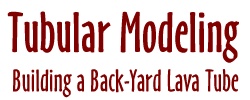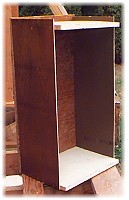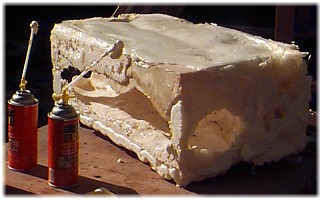 |
 |
 |
| Step 4: Burying the Tubes |
 Once trimed, the next stage involved burying the tubes. For this proceedure, a simple wooden mold was constructed. This was lined with plastic, to facilitate the removal of the mold after the process was completed. It soon became apparent that the foam would not completely dry when it was not in contact with the air. This required filling in the voids in stages. The first of which was to run a bead of foam around all the cut zones, and in the case of the skylight tube, in a ring around the opening of the sink hole. Then addition foam was squirted in key areas in stages. Once trimed, the next stage involved burying the tubes. For this proceedure, a simple wooden mold was constructed. This was lined with plastic, to facilitate the removal of the mold after the process was completed. It soon became apparent that the foam would not completely dry when it was not in contact with the air. This required filling in the voids in stages. The first of which was to run a bead of foam around all the cut zones, and in the case of the skylight tube, in a ring around the opening of the sink hole. Then addition foam was squirted in key areas in stages. |
 After hardening, the wooden mold was removed. Over all, the process went quite smoothly. Extra foam needed to be trimmed, and the surface will need major re-working to duplicate our lunar ideal. Extra voids were filled in with non-expanding liquid resin and a special high-expansion epoxy foam that does not require atmospheric contact to harden. The final block houses two lava tube sections, so that a view is available for each side. And while our model does have a bit of a "cheesy" appearence, it is indeed shaping up! After hardening, the wooden mold was removed. Over all, the process went quite smoothly. Extra foam needed to be trimmed, and the surface will need major re-working to duplicate our lunar ideal. Extra voids were filled in with non-expanding liquid resin and a special high-expansion epoxy foam that does not require atmospheric contact to harden. The final block houses two lava tube sections, so that a view is available for each side. And while our model does have a bit of a "cheesy" appearence, it is indeed shaping up! |



The Caves of Mars Project is funded by a NIAC Phase II Grant from the NASA Institute for Advanced Concepts.
Copyright © 2002-04 - Complex Systems Research; Inc. |
Once trimed, the next stage involved burying the tubes. For this proceedure, a simple wooden mold was constructed. This was lined with plastic, to facilitate the removal of the mold after the process was completed. It soon became apparent that the foam would not completely dry when it was not in contact with the air. This required filling in the voids in stages. The first of which was to run a bead of foam around all the cut zones, and in the case of the skylight tube, in a ring around the opening of the sink hole. Then addition foam was squirted in key areas in stages.
After hardening, the wooden mold was removed. Over all, the process went quite smoothly. Extra foam needed to be trimmed, and the surface will need major re-working to duplicate our lunar ideal. Extra voids were filled in with non-expanding liquid resin and a special high-expansion epoxy foam that does not require atmospheric contact to harden. The final block houses two lava tube sections, so that a view is available for each side. And while our model does have a bit of a "cheesy" appearence, it is indeed shaping up!